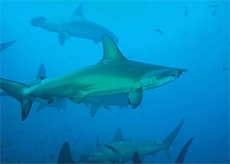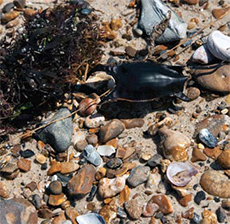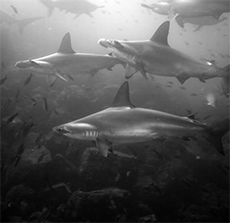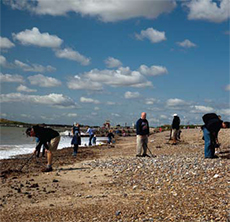




| Home | Features | Club Nights | Underwater Pics | Feedback | Non-Celebrity Diver | Events | 18 July 2025 |
| Blog | Archive | Medical FAQs | Competitions | Travel Offers | The Crew | Contact Us | MDC | LDC |

|

|
 
 |
 |
ISSUE 11 ARCHIVE - NATURE'S SUPER FISHDr John CarlinThe Bugatti Veyron is currently, at the date of writing this article (any petrol heads feel free to write in and correct me if I am wrong), the world's fastest production car. It came about when Volkswagen boss Ferdinand Piech bought Bugatti and had someone design a concept car that would develop 1000 horsepower and over 250 mph. His engineers were horrified and many said it could not be done.Every part of this super car needed to be carefully designed and tested. It took five years and fifty engineers just to create the sevenspeed double clutch for the Veyron. So my esteemed readers and fellow writers why in a marine biology column have I suddenly turned into Jeremy Clarkson? |
 |

|
Well, I believe that the shark is nature's super fish and in this article I will
try and convince you of this. The shark belongs to a taxonomic class
called the Chrondrichtytes – the 'cartilaginous fish'. This is because
the shark has a simple internal skeleton formed by the same flexible
material found in our own ears – cartilage (not ear wax).
Just like cars there are many different types of sharks with around 500+ known species and rising and there are 600+ species of rays. They vary from the tiny cookie cutter shark which is just 30cm to the largest living fish in the ocean – the whale shark at 20 metres. And it's not just size but also shape from the recognisable hammerhead shark to rays which are affectionately referred to as pancake sharks (note to Andy Maxwell, that this does not mean you can cook rays on Shrove Tuesday with a bit of lemon and sugar). |
|

|
Unfortunately popular culture has been a factor in the downfall of one of
the most successful creatures the world has ever seen. The shark is one
of nature's greatest designs. In comparison to man, the shark is an old
age pensioner having been around for approximately 400 million years.
Everyone has seen or heard of the now infamous Hollywood blockbuster which was based on a novel by Peter Benchley and directed by Steven Spielberg. Even the soundtrack to the film 'Jaws' will, for many, instantly conjure up the images of a great white shark with those lifeless black eyes hunting down a poor defenseless human being. Jaws was released in 1975 and although it is considered a thriller-horror classic it is responsible for introducing and perpetuating many of the negative stereotypes about sharks and their behaviour. The film was so powerful that, for a long time, many people were afraid to swim in the sea. |
 |

|
Unfortunately nothing could be further from the truth. In fact, everyone
stop using toasters NOW! I mean it, as they are far more dangerous
than sharks. If you don't believe me, check these statistics out: Last
year there were four shark-related deaths but a whopping 791 people
were killed by defective toasters. My favourite statistic of the lot is that
you have more chance of being bitten by a New Yorker than by being
bitten by a shark (I'd maybe re-think any holiday plans to America).
Peter Benchley actually turned into a shark advocate and publicly stated he would not have written the original novel had he known what sharks were really like in the wild. He subsequently wrote two nonfiction books called 'Shark Trouble' (about shark behaviour) and 'Shark Life' (his experience diving with sharks). |
|
|
Returning to 'Jaws', sharks actually have amazing teeth. Unlike humans
who only have two sets in their life time (discounting dentures) sharks
have an unlimited supply of teeth. New teeth are formed in a groove
just inside the mouth behind a series of teeth. These teeth move
forwards as if they are on a conveyor belt and replace the front teeth
which become worn and eventually fall out. Sharks teeth can last
as little as eight to ten days up to several months depending on the
species of shark, and the size and shape of the teeth vary depending
on the shark and the prey it eats.
If you have ever dived in South Africa in the day you will often find grey nurse sharks (which are commonly referred to as ragged tooth sharks because of their teeth) in groups sheltering in caves or gullies. If you look carefully you will see their distinctive teeth littered across on the floor. Sharks have a very cool type of skin. This has even been copied by swimsuit designers and was so effective at increasing a swimmer's performance they were banned in 2009. Sharks have a very tough skin which is actually covered by placoid scales (also called dermal denticles) which look like teeth. These scales cannot grow in size but actually increase in number as a shark grows and matures. Scientific studies have shown that as water passes over the shark's skin vortices are created by the scales that reduce drag. I have seen how efficiently sharks move through the water whilst diving in a strong current, and along with their hydrodynamic shape they moved effortlessly in comparison to myself (I was very jealous of the diver who shot past me on a DPV which is just plain cheating). There is another misconception that sharks are just stupid eating machines. In fact, they have a relatively large brain with the hammerhead shark having the biggest and most complex one. Sharks use smell to detect prey, but they also use it to locate the opposite sex for mating. Sharks eyes are extremely sophisticated and similar to mammalian eyes. When the shark gets closer to its prey it switches from smell to sight to locate its meal. Humans have touch as one of their five senses. Sharks also have touch but are more sensitive as they have something called a lateral line which is used to detect minute pressure changes and vibrations in the water. One of the most extraordinary senses is the shark's ability to detect tiny electric fields which are given off by living animals and inanimate objects. The Ampullae of Lorenzini are the electroreceptor organs which sense these electromagnetic fields. These organs are scattered around the head and the mouth of the shark. These receptors allow sharks to detect prey hidden in the sand and can be used for navigation by detecting the Earth's magnetic field. The light weight and flexible cartilage skeleton of a shark means that they are capable of turning in a very tight circle. They produce forward propulsion by tensing one side of their body's muscles which flexes their tail (caudal fin), which then relaxes whilst the other side tenses to produce the undulating movement that is so characteristic of many sharks swimming. As the caudal fin pushes them forward it also pushes them down, so the sharks use their pectoral fins on the side of their body like the wings of planes to give them lift to counteract this. They use the dorsal fin on the back to turn and manoeuvre in the water. The dorsal fin can also be used for identification of individuals within a species, by the marks (including pigmentation patterns) and injuries (caused by fighting and/or mating). |
 | |
|
The tiger shark is known affectionately as 'the dustbin of the ocean'
and will eat pretty much anything including things such as old tyres and
license plates. However, the majority of shark species are fussy eaters
and are specialised to feed on a relatively small number of prey items
(which does not include humans). In fact, the largest sharks, such as the
basking shark (which grows up to about ten metres and can be seen
in UK waters) and the whale shark are plankton eaters. It may surprise
you that we actually have over thirty species of sharks in UK waters and
numerous rays. However, both our native sharks and shark populations
globally are under threat from mankind. Unfortunately due to over-fishing
and finning (the wasteful and cruel practice to make shark fin soup) an
estimated hundred million sharks are killed every year this way.
If something is not done soon to reverse this trend, shark populations will continue to decline, potentially until the last individuals have been removed and species become regionally extinct. There are now a hundred and ten species of Chondrichthyan fish listed in a threat category on the IUCN's Red List, with a further ninety-five species listed as 'Near Threatened'. Founded in 1989, a program called Project AWARE was created by a group of environmental advocates at PADI, who were concerned about emerging threats to the underwater world. In 1992 the Project AWARE Foundation was created as a separate non-profit organisation. Project AWARE's ongoing partnership with PADI encourages involvement of divers and scuba professionals in conservation activities across the globe. The mission statement is to mobilise the world's divers into a global force to protect our ocean planet. And you can do something today. Visit Project AWARE to sign an online petition to protest against CITES (Convention on International Trade in Endangered Species) recent failure to restrict the trade of eight endangered shark species. We also need to change public perception of sharks through education. There are materials that are free to download from the Shark Trust. You can also actively take part in events such as the Great Eggcase Hunt on your local beach and try to identify the empty egg cases. Each species of shark and ray has a different size and colour egg case (free identification guides on the Shark Trust web site). The information collected will be used to identify nursery grounds and create marine protected areas. Sharks are a very misunderstood species but they are vital to the health and positive evolution of our marine ecosystem. Like most top predators they feed on the sick and weak keeping the schools of fish on which they feed healthy and the gene pool strong. So please take a bit of time to think about the plight of sharks and remember watch out for hungry New Yorkers and don't eat toast for breakfast. |
 | |
Previous article « Sharkipedia Next article » An Armchair Diver's Guide to Technical Rig Set Up Back to Issue 11 Index | ||